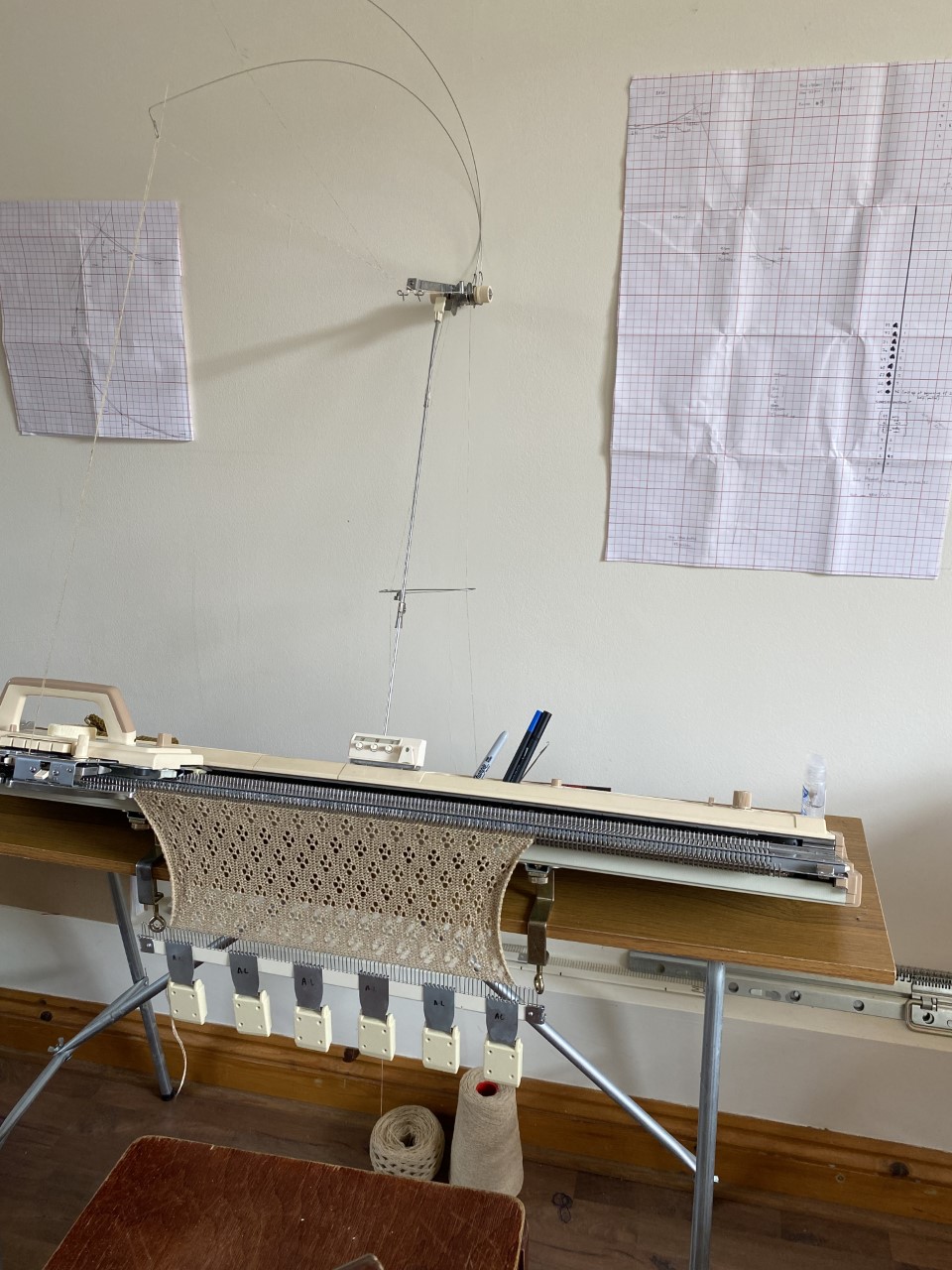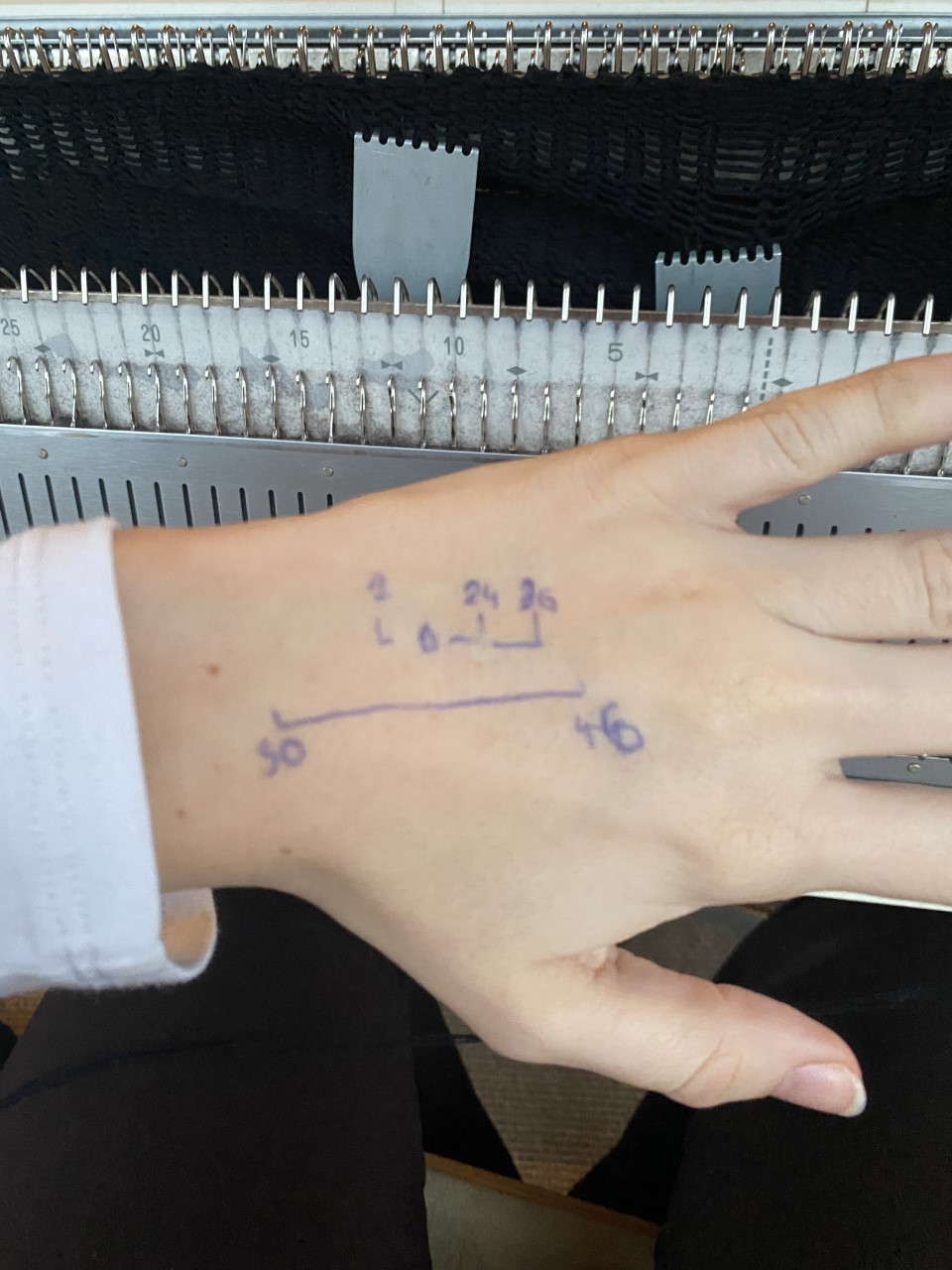- youtube
- bluesky
- Home
- About
- Costume Journal
- Membership
- Conference & Events
- Grants & Awards
- News & Social
In this week's blog, knitwear studio assistant Amy Llewellyn recounts how a chance discovery of a second-hand knitting machine has influenced her practice. Amy talks us through the process of creating a pair of beautiful knitted 19th-century style drawers, referencing the historical inspirations that inform much of her work.
Until last autumn, I worked part-time at a members’ club in the Kent countryside. During one shift, a customer who I had served regularly for several years asked me, “So what is it you do when you’re not here?”. I responded by telling him I assist, part-time, at a knitwear studio in London. We make jumpers, hats, skirts. He told me his mother used to hand knit but I interjected, telling him that we use knitting machines. “That’s not the same! That’s not real knitting!”
Although abrupt and a little rude, he was right about machine knitting not being the same as hand-knitting. Whenever non-knitters ask what machine knitting is, it’s easier to try and forget all about the pair of needles and little ball of yarn. A domestic knitting machine is a piece of ‘flatbed’ equipment, resembling something between a loom and a keyboard. But also very unlike both of those things. Usually, it is attached to a narrow purpose-built table and has countless parts like dials, counters, clamps and readers. Its paraphernalia is bitty and easy to misplace; claw weights, multi-pronged handheld tools and spiky combs with teeth, always bent out of shape. It has a wobbly aerial which some people call the ‘bughead’ for its resemblance to an insect with antennae. Yarn is threaded through this wiry mast and runs down to an opening in the carriage, which sits on the bed of needles and is pushed by the user from left to right and back again. This feeds yarn across the needles, which are brought forward by the tracks inside the carriage. Each needle has a latch which opens and closes, pulling yarn into itself, through loops inside loops inside loops. The knitting machine has its limitations, of course, and a whole collection of flaws. They need to be serviced, demand oiling, they break and need replacement parts.
Little to no new domestic machines are manufactured nowadays meaning the whole of the domestic machine knitting community runs along the underground channels of eBay sellers and the borrowing of parts (bearing someone else’s initials) from a friend of a friend. In an odd tale that can only really described as me being incredibly jammy, I found my knitting machine on the street. It was leaning up against a lamppost, being thrown out by a household in South East London*. I didn’t know what it was at the time so I consulted YouTube when I made it home. It felt like someone had been hiding a whole world from me which, to be fair, they probably had. Increased demand results in scarcity, and the rarer they become, the more expensive machine knitting gets. Naturally, there is a limit to how many machines can be found hiding in grandparents’ lofts and cupboards.
The garments I knit on my machine always speak to history. I like to reconstruct things I see in archives or old photos and fabricate them out of wool instead of their original woven fabrics. One day, after punching in keywords into the MET’s online collections, I found several pairs of late 19th century drawers. A couple of these were particularly more charming to me than the others - white cotton with baby pink ribbon running along the gathered lace frills at the hem. With little to no budget and without an exact method for fabricating a trouser leg, I attempted to recreate these in some leftover ecru wool. I drew some shapes onto squared paper, altering (poorly) some pattern from the internet. In order to make puffy leg pieces, I would have probably had to make several panels for each leg. I consulted my limited yarn supply and decided to cut some corners, hence these drawers are little less billowy than I would have liked. For the first time, I created a lace pattern in knitting to make the frills - a technique that has since become a staple in my more recent work. One specific part of my machine which would usually automate this process is broken so I make each individual lace hole. I found some old ballet shoe ribbon left over from childhood dance competitions and ran it through some holes I had knitted into the ribbed hem. Not an exact replica, but an achievement.
In these wooly drawers is built-in evidence of the capabilities - and boundaries - of both the 20th century knitting machine and its 21st century user. Whilst the machine has its own mechanisms which it carries from the 1980s, I have mine too. I use my laptop to look at online museum collections, I create digital spreadsheets to write out patterns. I use an iPhone calculator to do sums against tension swatches and I listen to music through headphones. I enjoy these blended timestamps, even though they are not evident to others. I appreciate the machine and my reference points for their own specific histories as well as recognising my small, personal contribution to whatever tradition of which I might be a part. My knitting machine can make me sweaty and stressed (and cry) but I am grateful for its it nourishing of my interest in objects from the past. It is a great machine and an incredible way to knit, even if some people don’t think it’s real knitting.
* I often wonder if the owner just propped it up to run and fetch something they had forgotten from inside. So, if anyone reading this is now without their Brother KH-930 by their side, I’m sorry, I really am.
To explore more of Amy's work, visit her website, and follow her Instagram to stay up-to-date with her upcoming projects.
If reading about Amy's work has peaked your interest in historic-inspired garment making, revisit our previous blog post on the reproduction of an iconic 1930s costume.
Image gallery

Knitting a lambswool lace top on single bed machine.

Lambswool drawers based on pairs held in the MET museum collections. With permission of Inez de Rijke.

Knitting a lambswool cardigan using punchcard.

Amy's "cryptic instructions on my hand".